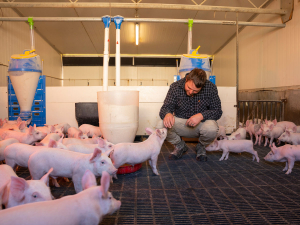Pig farmers respond to new welfare standards
Pig farmers are cautiously welcoming new animal welfare standards announced by the Government last week.
 Pig farmers claim the Government is saying land impacted by the policy should only be for certain types of farming and pig farming is not one of those.
Pig farmers claim the Government is saying land impacted by the policy should only be for certain types of farming and pig farming is not one of those.
The Ministry for the Environment (MfE) has found itself in a stoush with NZPork over the controversial National Policy Statement for Highly Productive Land (NPS-HPL).
The NPS-HPL aims to ensure the availability of favourable soil for food production while more land is opened up for housing projects.
Last week, pork farmers accused MfE, along with local councils, of misinterpreting the policy statement, leading to the exclusion of pig farms from land suitable for agriculture.
NZPork chief executive Brent Kleiss says it has been led to believe that the MfE is saying land impacted by the policy should only be for certain types of farming and pig farming is not one of those.
“This interpretation of the policy will make it hard for new pig farms to be established and for existing farms to grow or change the way they do things,” Kleiss says.
He says pig farms are often part of bigger farms where pig manure is used as a natural fertiliser on cropping and pastoral land.
“This is why many pig farms are on land that’s considered good for farming under the policy,” he says.
Kleiss says NZPork has asked the Government to change its policy to ensure it protects good farming land while allowing for pig farming.
He says consultation on the proposed NPS-HPL stated the intention to protect highly productive land for ‘primary production purposes’ in an effort to avoid the loss of highly productive land to uncoordinated urban expansion and rural land fragmentation.
“NZPork supported that,” he says. “However, the published version of the statement changed that wording to ‘land-based primary production’.”
Kleiss says this is being interpreted by MfE staff to mean that despite being a primary production food-producing activity, indoor primary production activities like pig farms are an inappropriate land use on highly productive land.
“We are also seeing this interpretation from councils as they begin to implement the NPS-HPL.
“We believe the current interpretation of the policy is inconsistent with its original intent of protecting highly productive land for primary production and represents an overreach in a policy initially proposed to protect land valued for food production from urban activities.”
MfE says the Government has committed to reducing consenting barriers for infrastructure, housing and primary production.
“This includes MfE exploring options to amend the NPS-HPL to enable more flexibility of what activities can occur where,” a spokesperson told Rural News.
The spokesperson says officials have reviewed submissions from consultation last year on two potential amendments to the NPS-HPL.
“These related to the development of new specified infrastructure: renewable energy generation, intensive indoor primary production such as pig farming and greenhouses on HPL.
“Ministers will seek a Cabinet decision on these potential changes later this year.”
Salmonellosis is a serious disease in cattle.
Drench resistance is already hitting farm profits; it's not just a future problem.
Engaging, thought provoking speakers, relevant seminars and relatable topics alongside innovative produces and services are the order of the day at the 2026 East Coast Farming Expo.
Farm supplies trader Ruralco has recovered from two consecutive years of losses to post a $1.25 million profit for the 2025 financial year.
Naki Honey, a New Zealand manuka apiary company, has crafted what is believed to be the world's most expensive honey.
OPINION: Wool farmers believe the future of strong wool still holds promise.